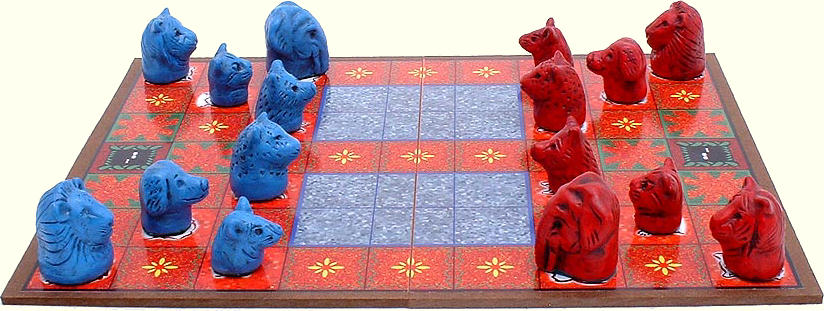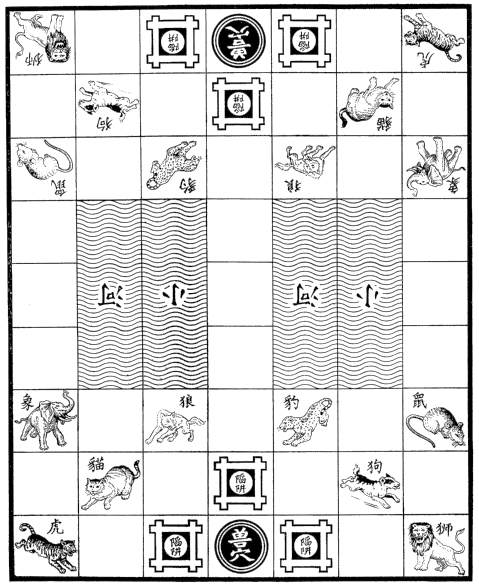Dou Shou Qi
The Battle of Animals

Dou Shou Qi is an old Chinese game for two players. Its name is pronounced doe show chee
and means fighting animal game.
It is also known by such nicknames as “the jungle game,” “animal battle chess” and even, in Asia, “children’s chess.” One can debate whether this game is a chess variant or not, but a certain close kinship cannot be denied. The presence of differentiated pieces and the captures by displacement are obviously chess-like elements. Moreover, it is likely that it was originally derived from Xiangqi, the Chinese form of Chess. One can find descriptions of this game in several game books.
Rules
Equipment

The game is played on a board of nine rows and seven columns. Several squares are marked with drawings or symbols. The central squares of the 1st and the 9th rows are the Dens. Each den is surrounded by three Traps. Two Lakes of six squares each stand in the center of the board.
Each player has eight pieces: an Elephant (象), a Lion (狮), a Tiger (虎), a Leopard (豹), a Dog (狗), a Wolf (狼), a Cat (猫), and a Mouse or Rat (鼠). As in Xiangqi, they are typically uniformly sized discs, red for one side, blue, green or yellow for the other. But as the photograph at the top of the page indicates, figurine pieces may also be used. Before the game starts, the pieces are placed on their squares, which show images to indicate the starting position of each animal.








Moves and Captures
Blue starts the game.
All pieces move by taking one step horizontally or vertically, never diagonally. Captures are made by one piece moving in and taking the place of the other (as in chess). Capturing is not compulsory.
The pieces can only capture adversaries which are of lower or equal power. This is the hierarchy, from strongest to weakest:
Elephant > Lion > Tiger > Panther > Dog > Wolf > Cat > Rat
In addition, the Rat can take the Elephant. To explain this, it is said that it crawls into the Elephant’s ear and eats its brain!
Any animal can capture the same type of animal, which is of equal power. In this case, whichever animal strikes the other becomes the one making the capture.
Many players are surprised that the Dog is superior to the Wolf; moreover, this does not seem in agreement with their respective positions on the board. But some versions of the rules reverse these and play with the Wolf stronger than the Dog. Some sources replace the Wolf with a Fox, eliminating the doubts, as a Dog is perceived as stronger than a Fox. In any case, this has practically no impact on the game, as those pieces seldom meet each other.
Particular Rules
The Traps: All pieces move freely on and off the trap squares, but an animal which has moved onto the opponent’s trap square loses all of its power and may be captured by any other animal, no matter how low in rank.
The Rat and the Lakes: Only the Rat may move on the squares of the lakes. While there, it is safe from capture from any other piece, except for another rat which may also swim in the lake. The Rat is not allowed to capture on the move of entering the lake or stepping back onto dry land. Therefore, it may not attack the Elephant from the water, and may not attack another rat while crossing to or from the water.
The jumps of the Lion and the Tiger: These two animals can jump over the lakes, from one bank to the other, straight forward, backward, or side-to-side. They are allowed to capture in this move, pouncing on an animal across the water. Jumping over the lake is not allowed, however, if a Rat is in the water, blocking the path of the Lion or Tiger.
No animal is allowed to enter its own den.
It is illegal to repeat the same position twice.
End of the Game
The goal is to move one piece – any animal – into the opponent’s den.
Variant Rules
This game is sometimes played with minor variations in the rules, which lead to a different game. Some of them deserve to be tried:
- The Elephant cannot eat the Rat. In this case, the Rat takes on a greater importance, and the game invites a higher degree of tactical maneuvering.
- The Panther can jump over the lake, but only side-to-side (horizontally), providing it does not leap over the Rat in the water.
- The Lion is not allowed to jump over the lake horizontally.
- The Lion and the Tiger are equally strong; either one may capture the other.
- The Rat may capture another Rat from land to lake or from lake to land.
- The Dog (because it is a good swimmer) can also move in the lake. In this case, it is subject to the same limitations as the Rat.
- The traps weaken all pieces, whatever their side. A piece standing on a trap may be captured by any piece, regardless of power ranking, even if it is on its own side of the board.
The description given here is based mainly on the book “A World of Chess, Its Development and Variations through Centuries and Civilizations” by Jean-Louis Cazaux and Rick Knowlton, McFarland, 2017.
The photographs are from Rick Knowlton, https://ancientchess.com.
WWW page created: May 28, 1997. Last modified: August 25, 2021.
